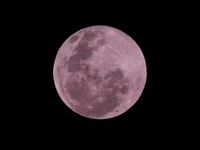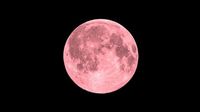On the night of April 13, 2025, the sky will be illuminated by the much-anticipated "Pink Moon," marking the first full moon of spring in the Northern Hemisphere and autumn in the Southern Hemisphere. Despite its name, the moon will not actually appear pink; instead, the term "Pink Moon" originates from the blooming of the Phlox subulata, a pink flower that emerges during this time of year in North America. The peak of the full moon will occur at 00:22 (Brasilia time) on April 13, when the moon reaches its apogee, the farthest point from Earth in its orbit, making it a "microluna."
The Pink Moon is a significant astronomical event that draws the attention of sky watchers and casual observers alike. This year, it will be particularly special as it coincides with the occultation of the star Spica, located in the constellation of Virgo. Observers in regions such as Central and South America, as well as parts of southern Africa, will have the chance to witness this rare phenomenon, where the moon temporarily obscures the star. The peak brightness of the full moon is expected at 21:22 (Brasilia time) on April 12, 2025, when it will be positioned close to Spica, one of the brightest stars in the night sky.
The Pink Moon not only captivates astronomers but also holds cultural significance in various traditions. In Christianity, it is referred to as the "Pascal Moon," as it helps determine the date of Easter, which will be celebrated on April 20, 2025, the first Sunday following the first full moon after the vernal equinox. This connection between lunar phases and religious observances highlights the intertwined nature of astronomy and cultural practices.
For those eager to observe the Pink Moon, no special equipment is required. The best viewing experience can be achieved by finding a location with minimal light pollution, such as rural areas or parks away from city lights. The moon will begin to rise on the eastern horizon around 18:30, providing an excellent opportunity to appreciate its beauty as it ascends into the night sky. As it rises, the moon may appear larger and take on orange hues, creating a stunning visual spectacle.
As a part of this celestial event, enthusiasts are encouraged to engage in reflection and appreciation of the natural world. Astrologer Paula Arruda suggests that the Pink Moon is a perfect time for introspection, allowing individuals to assess their relationships and prioritize time spent with loved ones. It is a moment to embrace change and transformation, making it an ideal occasion for setting intentions and closing chapters.
The Pink Moon is just one of many full moons that carry special names and meanings throughout the year. Each full moon is associated with different characteristics and cultural stories, such as the Strawberry Moon, Hunter's Moon, and Wolf Moon. These names serve as a reminder of how ancient sky watchers used lunar cycles to mark time and seasons, reflecting a deep connection between humanity and the cosmos.
In summary, the Pink Moon on April 13, 2025, presents a unique opportunity for stargazers and casual observers alike to witness a beautiful celestial event. With the moon at its apogee, it will be classified as a microluna, appearing smaller and less bright than typical full moons. This year’s event is further enhanced by the occultation of Spica, making it a must-see for astronomy enthusiasts. As the moon rises, it invites everyone to reflect on the beauty of nature and the significance of celestial events in our lives.
Mark your calendars for this enchanting night, and prepare to gaze at the sky as the Pink Moon graces us with its presence. Whether you’re an experienced astronomer or simply looking for a moment of wonder, this full moon will surely captivate hearts and minds alike.








